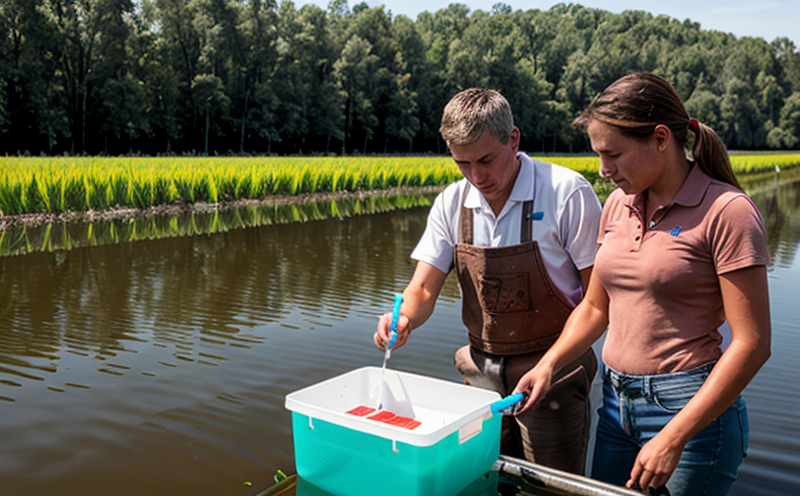Phosphate Content Testing in Irrigation Water
The phosphate content in irrigation water is a critical parameter that impacts agricultural productivity and environmental health. Excessive phosphorus can lead to nutrient imbalance, which may result in reduced crop yield, increased weed growth, and eutrophication of nearby water bodies. Thus, accurate and reliable measurement of phosphate levels ensures optimal crop nutrition while minimizing ecological harm.
Phosphorous is a vital component of nucleic acids (DNA) and plays key roles in photosynthesis and energy transfer within plants. Adequate phosphorus supply supports robust root development, efficient nutrient absorption, and overall plant growth. Conversely, insufficient phosphorus can stunt plant growth and reduce yields. Therefore, it's essential to maintain the right balance for sustainable agricultural practices.
Water quality testing laboratories employ various methods such as colorimetric assays or spectrophotometric analysis using reagents like molybdate-ammonium-p-nitrophenol (MNP) system for detecting phosphates. These techniques follow internationally recognized standards including ISO 11345:2017 which specifies procedures for determining phosphate in water by means of the Molybdenum Blue method.
Inaccurate measurements can lead to over-fertilization or underutilization, both of which have significant economic and environmental repercussions. Overuse of fertilizers not only increases production costs but also contributes to soil degradation and pollution of groundwaters. On the other hand, insufficient phosphorus levels might necessitate additional application at higher expense.
Regular monitoring helps farmers tailor their irrigation schedules more precisely according to actual conditions rather than relying solely on fixed intervals or weather forecasts alone. This precision enables better management practices leading ultimately towards increased efficiency and profitability.
Why It Matters
The importance of phosphate content testing in irrigation water cannot be overstated for several reasons:
- Environmental Protection: Ensures that excessive phosphates do not enter aquatic ecosystems, preventing harmful algal blooms and preserving biodiversity.
- Crop Health: Provides necessary nutrients to plants while avoiding toxic levels that could harm their health.
- Economic Efficiency: Avoids unnecessary use of fertilizers by providing accurate information about available phosphate content in water sources.
- Sustainability: Supports long-term sustainable agricultural practices by promoting efficient resource utilization and reducing waste.
A balanced approach to managing phosphates in irrigation waters enhances not only agricultural yields but also contributes positively towards ecological balance. By adhering to stringent quality control measures, laboratories ensure reliable data which can be used effectively by stakeholders involved in agriculture.
Quality and Reliability Assurance
To ensure the accuracy of phosphate content testing results, several quality assurance practices are employed:
- Standard Operating Procedures (SOPs): Detailed guidelines for sample preparation, reagent handling, instrument calibration, and data interpretation.
- Certified Reference Materials (CRMs): Use of standard materials to validate analytical methods and compare results across different testing facilities.
- Duplicate Analysis: Repeating tests on the same sample multiple times to assess variability within individual measurements.
- Interlaboratory Comparisons: Participating in proficiency tests where results are compared against established benchmarks set by recognized bodies like ISO or ASTM.
The use of these protocols guarantees consistency and reliability, ensuring that the data generated from phosphate content testing is trustworthy and actionable. This commitment to quality control underscores our laboratory's dedication to providing accurate and reliable information crucial for informed decision-making processes in agriculture.
Use Cases and Application Examples
| Use Case | Description |
|---|---|
| Farm Management | Monitoring phosphate levels helps in optimizing irrigation schedules based on actual crop needs, reducing water usage and associated costs. |
| Crop Nutrition Optimization | Determining the exact amount of phosphorus present allows for precise fertilizer application tailored to specific crops' requirements, enhancing efficiency without waste. |
| Environmental Compliance | Regular testing ensures compliance with local regulations regarding permissible levels of phosphate discharge into natural water bodies. |
| Research & Development | Phosphate content data from various locations aids researchers in understanding regional differences and developing targeted solutions for improved crop yields. |
The ability to measure phosphate accurately is vital not only for immediate applications but also serves as a foundation for future advancements in agricultural science. Our laboratory plays an integral role in this process by providing reliable testing services that contribute significantly towards sustainable farming practices worldwide.





